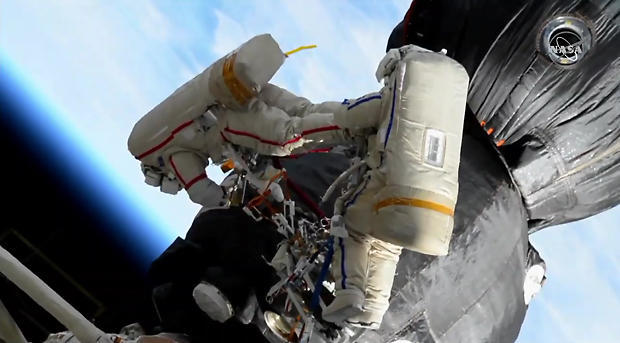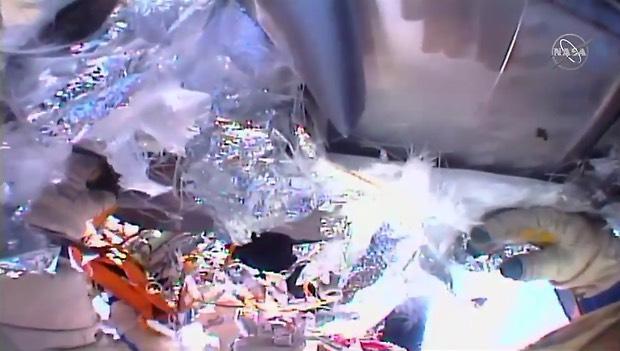Spacewalkers cut into Soyuz shield, find leak site
Two Russian cosmonauts ventured outside the International Space Station Tuesday for dramatic exploratory surgery on a Soyuz ferry ship scheduled to return to Earth Dec. 20, hacking through insulation with a knife and scissor-like shears to reach an area where a small hole was found inside the spacecraft last August.
Apparently the result of a deliberate act, an earlier station crew plugged the hole within a day of its discovery, and no issues are expected when the Soyuz MS-09/55S spacecraft undocks and returns to Earth next Thursday. The upper orbital module where the hole is located will be discarded, as usual, before atmospheric entry.
But Russian engineers want to find out more about the 0.08 inch-wide hole and the behavior of the sealant used to plug it. In the process, they may gain more insight into when it might have been drilled and thus who might be responsible.
"I don't know if we have a leading theory," Sam Scimemi, director of the space station program at NASA Headquarters, told the NASA Advisory Committee last week. "You can see the hole ... was drilled, we do know that. But the circumstances on how it was drilled, we don't have a clear answer on that."
Oleg Kononenko and Sergey Prokopyev, who will serve as the Soyuz spacecraft commander next week, opened the hatch of the Russian Pirs docking compartment at 10:59 a.m. EST (GMT-5) to officially kick off a planned six-and-a-half-hour spacewalk, the third Russian excursion this year.
Exiting Pirs, which is attached to the Earth-facing port of the Zvezda module at the aft end of the space station, Kononenko and Prokopyev made their way forward across the Zarya module, using an extendable boom to reach the Soyuz MS-09 spacecraft docked at another compartment attached to Zarya's Earth-facing port.
Getting the boom properly configured took longer than expected, and the cosmonauts did not reach the worksite until three hours into the spacewalk. Once in position, Kononenko, anchored to the end of the boom and assisted by Prokopyev, used a knife to saw through a multi-layer insulation blanket.
"Honestly, I can't look at that," Prokopyev said in translated remarks. "It's my vehicle, Oleg!"
Prokopyev was not alone. Veteran space reporters following along via NASA television were stunned watching Kononenko wield a sharp knife so close to their pressure suits while hacking away at the Soyuz's exterior insulation.
Kononenko initially planned to use the large pair of shears to cut out a 10-inch-long flap of insulation over the leak area, but he could not get properly positioned. Instead, he pressed ahead with the knife. Once done with the insulation, he used clippers to snip through micrometeoroid shielding, exposing the external hull of the upper compartment opposite where the leak was found inside.
The cosmonauts initially could not find the presumed hole. But a few minutes later, after an update from flight controllers on the hole's exact location, Prokopyev realized he had already seen it. Or at least the hardened epoxy that was used to seal the leak in August, forming a dark, irregular blob of material extending slightly above the hull.
"Oh yes, I can see it," he called. "I think that is the hole."
"That is exactly the hole we've been looking for, guys," a flight controller replied.
But Prokopyev was not sure, saying "no, it's not that one."
"No, it IS that one," mission control assured him.
"This one? (You're) serious?" Prokopyev's translator said, reflecting the cosmonaut's surprise.
"Yes, that one. It's the hole."
The cosmonauts then used forceps to cut off a small bit of the extruded sealant and applied sandpaper-like material to collect samples of materials around the hole. They originally planned to stretch insulation over the area, but Russian engineers decided it was not necessary.
After cleaning up the worksite, the two men headed back to Pirs, closing the hatch at 6:44 p.m. ET to wrap up a 7-hour 45-minute spacewalk.
Soyuz ferry ships are made up of three modules: an aft instrumentation and propulsion section; a central three-seat command module used by astronauts and cosmonauts during launch and landing; and an upper orbital module featuring rendezvous antennas and a docking mechanism. The orbital module also provides a bit of leg room and privacy during station rendezvous procedures that can take as long as two days to complete.
Only the central command, or descent, module carrying the crew makes it back to Earth. After an internal hatch is sealed, the upper orbital module and lower propulsion modules are discarded just above the discernible atmosphere and both burn up during entry.
The leak issue cropped up the evening of Aug. 29 when sensors aboard the space station detected a small decrease in cabin air pressure. It was not large enough to warrant waking the lab's crew, but the next day they traced it to the orbital module of the Soyuz MS-09/55S spacecraft. When they pulled back insulation, they found a small hole and nearby marks on the hull that appeared to have been caused by deliberate drilling.
The spacecraft was launched on June 6, carrying Prokopyev, German flight engineer Alexander Gerst and NASA astronaut Serena Auñón-Chancellor to the station. The assumption was that someone had attempted to repair the hole before launch and that the seal eventually gave way in the vacuum of space.
Dmitri Rogozin, head of the Russian space agency Roscosmos, raised eyebrows shortly after the leak was detected when he did not immediately rule out crew involvement, saying (in translated remarks) that it was a matter of honor to "find the one responsible for that, to find out whether it was an accidental defect or a deliberate spoilage, and where it was done -- either on Earth or in space."
Drew Feustel, the NASA astronaut in command of the station at the time, said in interviews later that no one on board had anything to do with the leak other than plugging it. Little else has been said about the matter in the weeks leading up to Tuesday's spacewalk, but the Russian investigation is still underway.
Kononenko and two crewmates — Canadian flight engineer David Saint-Jacques and Anne McClain — arrived at the station aboard their Soyuz MS-11/57S spacecraft on Dec. 3, joining Prokopyev, Gerst and Auñón-Chancellor.
Prokopyev and his two crewmates plan to return to Earth aboard the Soyuz MS-09/55S ferry ship next Thursday, landing in Kazakhstan just after midnight U.S. time to wrap up a 196-day mission.
"We've already done the (flight readiness review) for the 55S return and this was discussed in great detail," Scimemi said of the leak. "There is no reason to believe this will become unstable at any point. Again, this is on the on-orbit module, which is jettisoned. This part does not come back home with the crew, so we believe the risk is very low."
Tuesday's spacewalk marked the 213th EVA devoted to station assembly and maintenance since station construction began in 1998, the eighth so far this year, the fourth for Kononenko and the second for Prokopyev.







